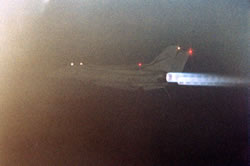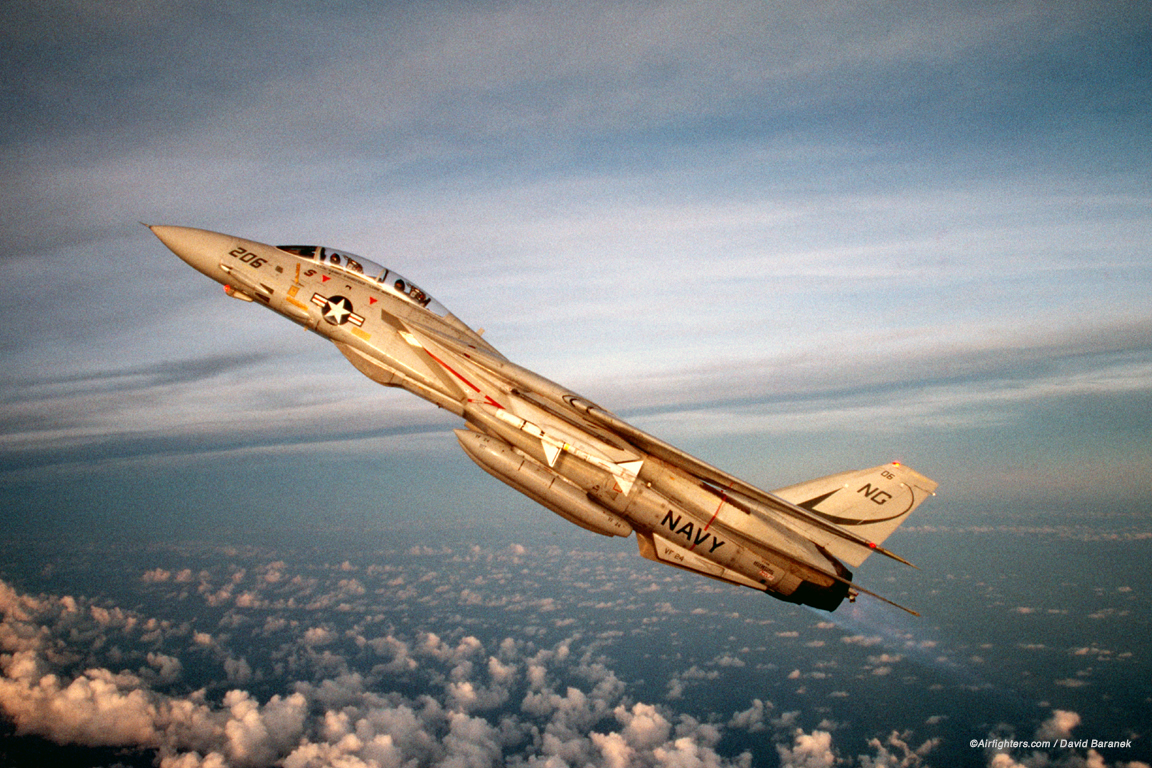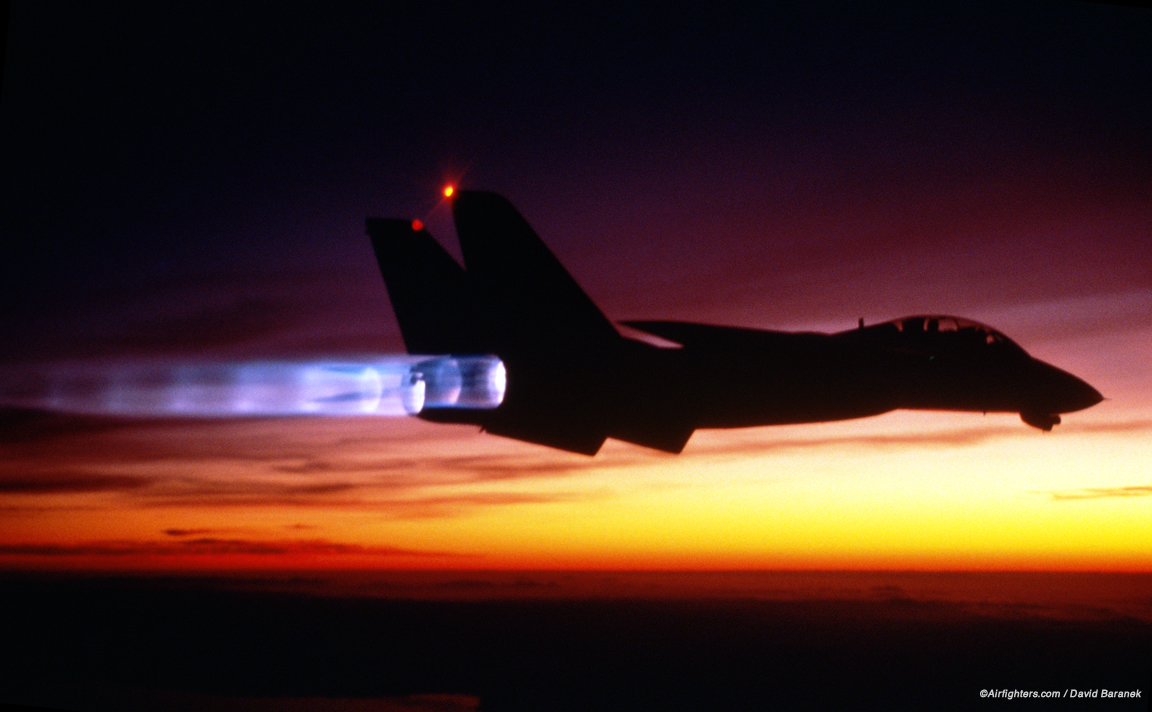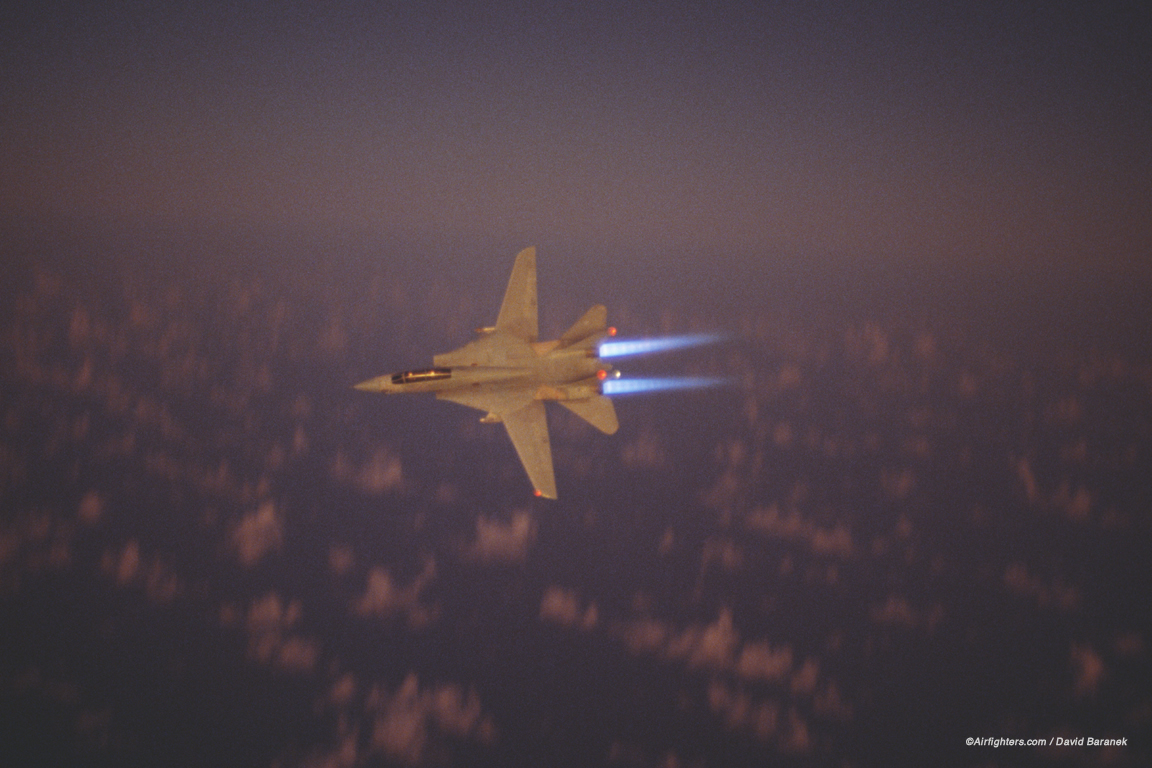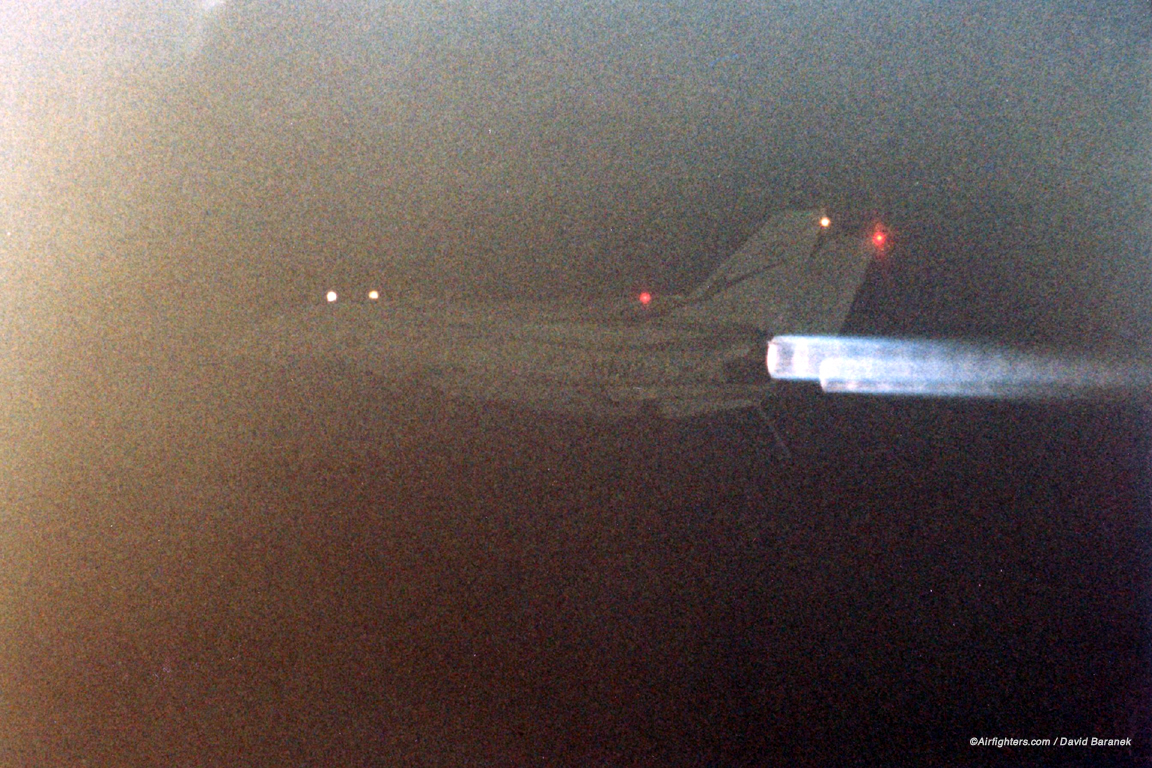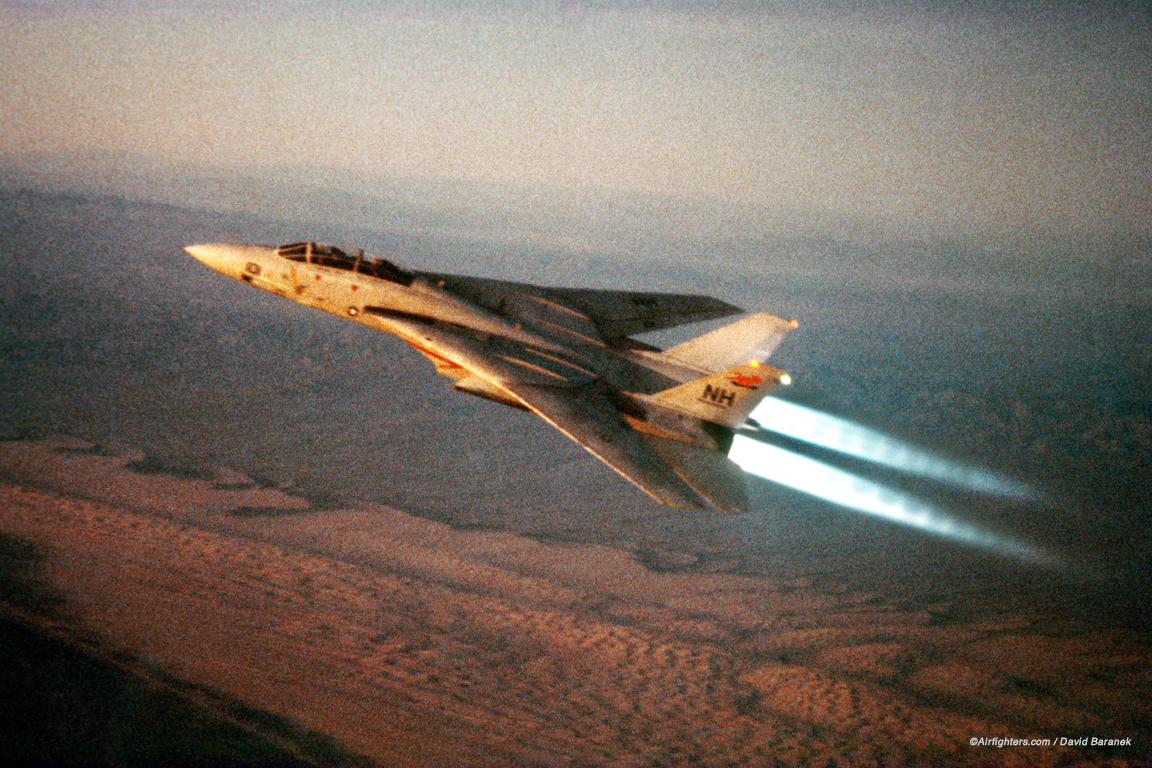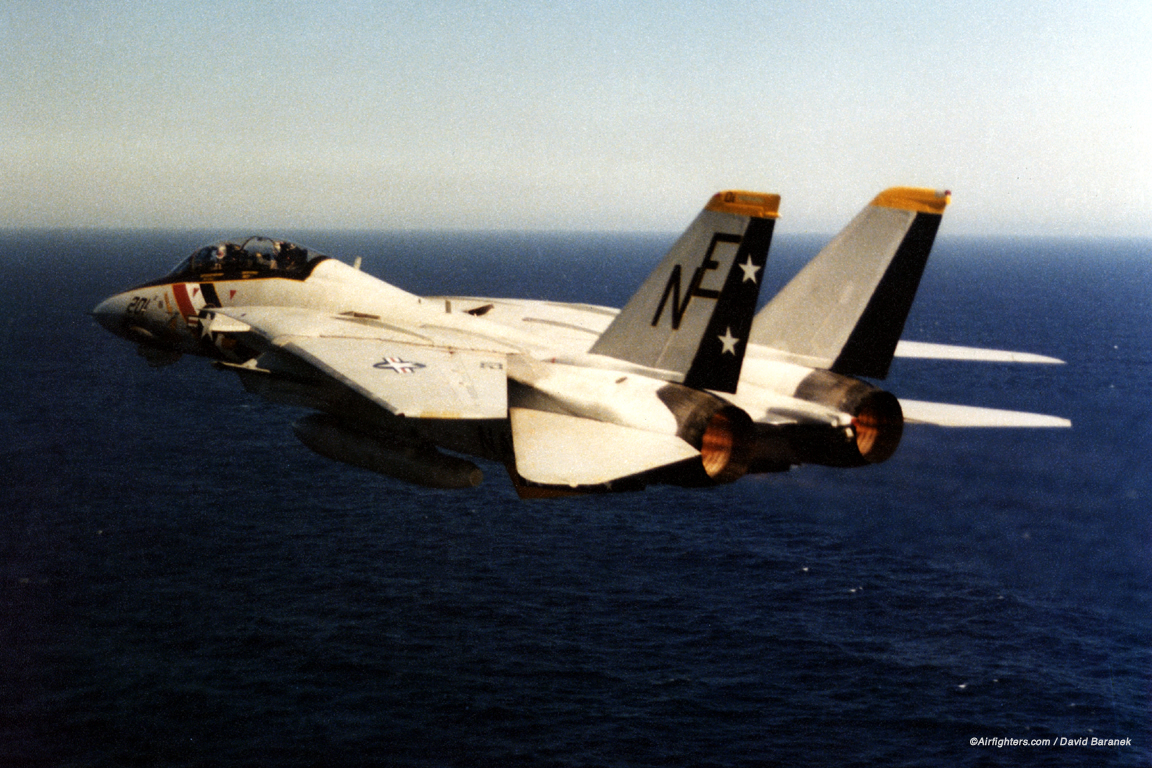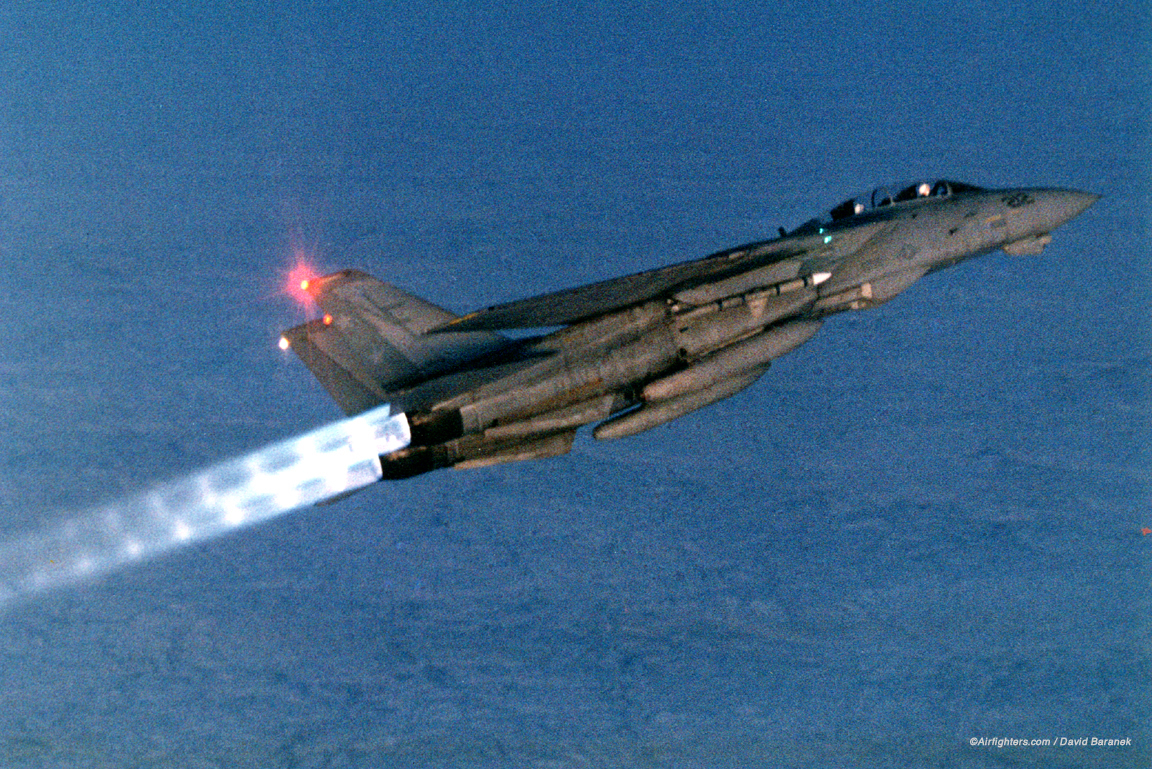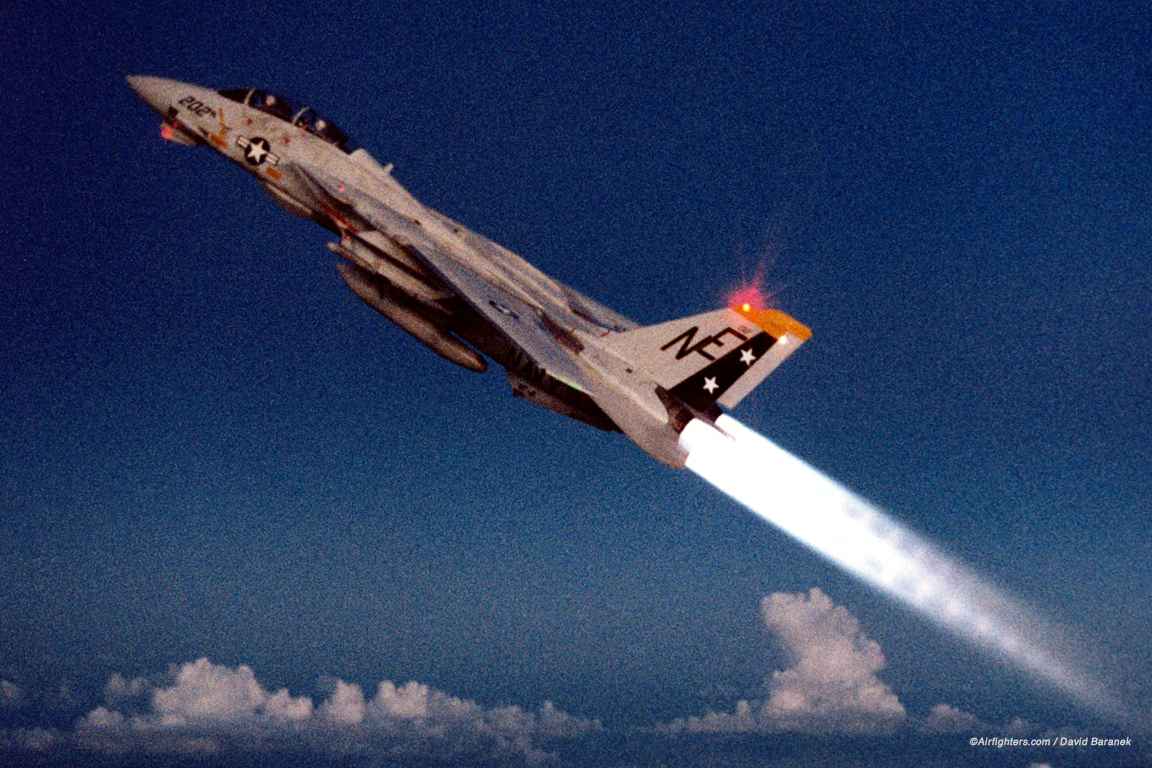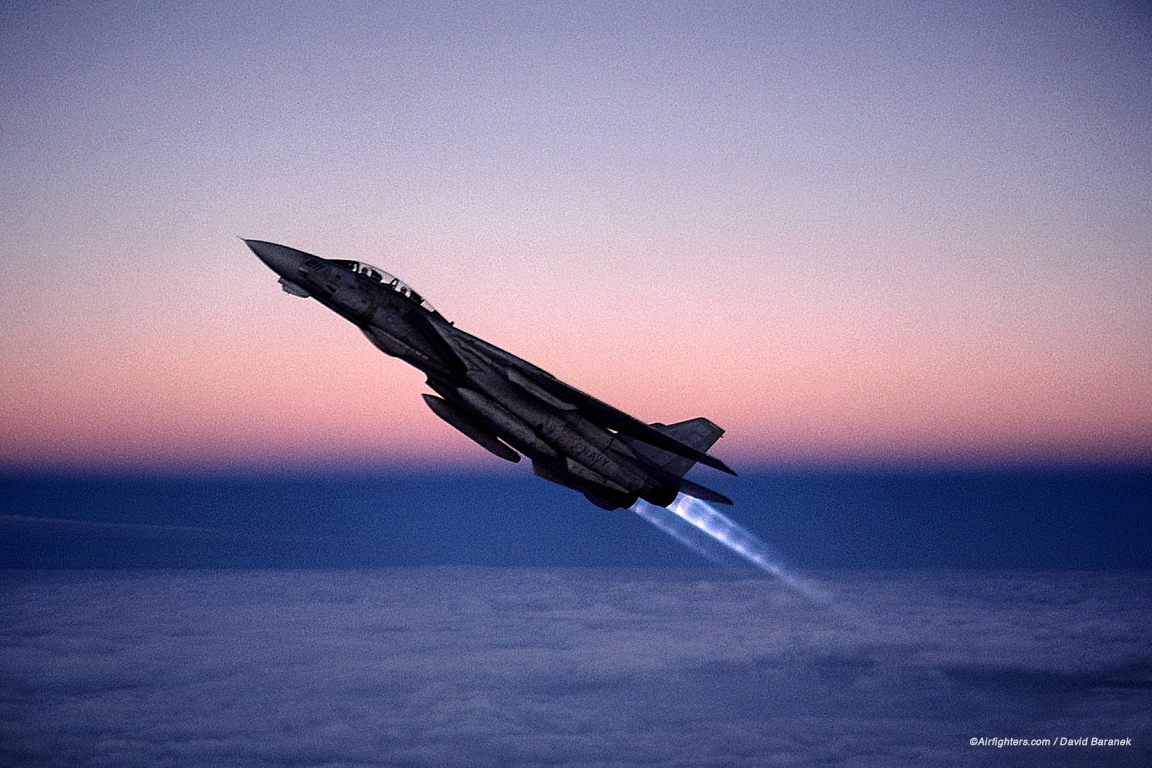
This is a story of my pursuit of good afterburner photos. I was an F-14 Tomcat radar intercept officer (RIO) and photography was a hobby. I would say I was a serious amateur, trying to take good photos, but also not committing too much effort or money to do so.
As a Tomcat RIO in the early 1980s, I had incredible opportunities for photography. We flew a lot both day and night, which meant that there were plenty of twilight flights. Maybe even more important, the in-squadron training attitude wasn't as rigorous as it later became. For much of the 1980s the F-14 and its weapons were superior to potential threats. The surface to air threat was less capable, too. And the US Navy hadn't yet instituted the Strike Fighter Weapons and Tactics qualification system that greatly enhanced aircrew training in the 1990s. We were diligent, but overall life was easier for Tomcat crews in the 1980s. That meant we had more fuel and time to expend on afterburner photos, two ingredients essential to almost any good photography.
Being in the Tomcat I automatically had another essential ingredient: a good subject. Yes, the F-14 could look chunky if shot from the wrong angle. But with its angular lines and complex features, it was usually photogenic -- it looked exciting and powerful, like a fighter should. And it had those huge burner cans, which dilated to full diameter when the pilot moved his throttles past the detent and into the "Afterburner" quadrant. I had excellent conditions for my pursuit of great air-to-air afterburner photos.
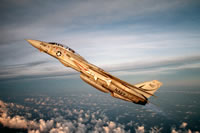 So how did I use these fantastic opportunities? Let me go through a few stories and show you the results.
So how did I use these fantastic opportunities? Let me go through a few stories and show you the results.
Early in my flying days I captured a decent shot of an afterburning F-14. This was in VF-24 in 1981. The jet was in a 30 degree climb, which wasn't actually planned but turned out to look cool. The background clouds were suitably interesting, and there was even a big white AIM-7E Sparrow missile on a pylon on my side of the jet. There was one problem: even though it was shot around sunset, the burner plume is not pronounced enough. Oh, you can see the lick of blue flame, but it's not prominent. As the years have gone by, I decided that I like this photo more and more, but I didn't consider it a success at the time. And I was just getting started.
Many people took burner shots silhouetted against the sunset. With the colorful sky and visible burner plumes these usually looked dramatic but they lacked something I thought was critical: you couldn't identify the squadron. So I shot a few, like this one, but only a few.
Several of us discussed photography and word got around that I was taking burner photos. One evening we were returning from a training mission and our wingman came up on the radio and said, "Hey, Bio, look at this." He was already in full burner and started to roll toward us, passed underneath, and then came out the other side in a vertical climb. I think I was using ASA 100 Ektachrome and shooting at 1/30, but it could've been slower. I grabbed my camera and started shooting, and the photo on the lower left is one of the shots I got. The lighting was good to show the burner plumes, but he was too far away and moving too much. An opportunity lost. Note: For this image, I did not use the image correction features in Photoshop Elements, so viewers get a better idea of the original conditions.
I should mention that for several months back then I used a borrowed Nikon and switched between a couple of fixed focal length lenses, 28 mm and 55 mm. I saved up and bought a Konica FS-1 with a modest zoom, about 35-85 mm. I think that qualifies as serious amateur.
After a year or so I got imaginative and tried to take a shot in full darkness, using a flash. I discussed it with everyone in the brief, and on the way back from a training mission, we got set up, lit the burners, and I took my shot.It turned out we were further away than I had planned based on pre-flight calculation, so it's underexposed. You can see some glare from my own canopy on the left of the photo, and the reflective tape on pilot and RIO helmets shows up as two bright spots near the front of the plane. I only tried this once.
I took a few other afterburner photos during my three and a half years in VF-24, none of them worth showing here. Then I received orders to the Navy Fighter Weapons School as a Topgun instructor. My responsibilities as an instructor were demanding, but I was up for the challenge. I had always wanted to get into the world of fighters, and at Topgun I was in it up to my ears! It was great -- both demanding and rewarding, on the ground and in the air. I did some "stock" photography, taking photos of every aircraft and aircrew for the end-of-class slideshow. I wonder where those photos are now....Sometimes we would end the flying day at MCAS Yuma (Arizona) and have to make an admin hop back to Miramar. On one of these events I asked an F-14 crew to join up on my F-5F and then go to full burner, and this was the result. I really liked this photo. Unfortunately the original slide was destroyed and all I have is a 6x9 inch Cibachrome print, but I think you get the idea. (I'm sure at least some other photographers have stories like this, of favorite photos lost or nearly lost, and I just want to say, so do I.)
After my two and a half year tour at Topgun I made a quick trip through the F-14 training squadron and then joined VF-2, returning to the F-14A Tomcat that I loved. Shortly after I returned I tried a full-burner photo in broad daylight and relearned what I already knew: the afterburner plumes on the TF30 engines of the F-14A couldn't be seen well in daylight. I would have plenty of opportunities for evening shots in the next few years. This would good from the standpoint of pursuing my afterburner photos, and luckily I got comfortable with night carrier landings.
 Rather than go into details on the next three images, I'll just make a few comments on them. I shot this one off the coast of Northern Mexico in November 1988, during an evening flight when we had a lot of fuel and our mission wasn't very demanding. It was after sunset, dark enough for the full burner cone and its details to be seen clearly, yet still enough sky glow to illuminate the squadron markings. Our two jets just roamed the sky for a minute or two in full afterburner, while I shot six or eight frames -- some silhouetting the lead, and others like this. I was shooting print film, probably ASA 100, and while this is a photo that I was happy with from the start, the 22-year-old 8x10 inch prints look so much better after getting some digital image correction.
Rather than go into details on the next three images, I'll just make a few comments on them. I shot this one off the coast of Northern Mexico in November 1988, during an evening flight when we had a lot of fuel and our mission wasn't very demanding. It was after sunset, dark enough for the full burner cone and its details to be seen clearly, yet still enough sky glow to illuminate the squadron markings. Our two jets just roamed the sky for a minute or two in full afterburner, while I shot six or eight frames -- some silhouetting the lead, and others like this. I was shooting print film, probably ASA 100, and while this is a photo that I was happy with from the start, the 22-year-old 8x10 inch prints look so much better after getting some digital image correction.
Several months later, in April 1989, our carrier (USS Ranger) was passing through the South China Sea and I was on a two-plane event scheduled to launch around sunset. When we passed through the Philippines a few days before, I had purchased some ASA 800 or 1000 print film for an occasion such as this. I thought about what I had learned and briefed the photo shoot in detail. Realizing that the F-14 accelerates quickly in full burner, and at higher speeds it was difficult to stay smooth in formation, I briefed to pull the nose up about 30 degrees to keep airspeed below 300 knots. 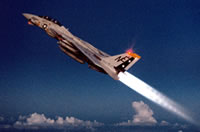 I also briefed for the lead to sweep his wings back to around 55 degrees, while my pilot kept our wings in automatic, which would give us an advantage in maneuvering to stay in formation. We met at 10,000 feet and got set up, then lit the burners and I started shooting. It was a few minutes after sunset, and it was so cool to see the lead jet climbing like a rocket that I lowered my camera a few times and just enjoyed the spectacle. I shot the whole roll as we climbed to 25,000 feet, and this is the best one. When we pulled into Singapore and I had the film developed, I was very happy. It would've been nice to get more definition of the features in the burner plume, but the negatives are gone (misplaced) so I only have a few 8x10 inch prints to work with. I even like the grain.
I also briefed for the lead to sweep his wings back to around 55 degrees, while my pilot kept our wings in automatic, which would give us an advantage in maneuvering to stay in formation. We met at 10,000 feet and got set up, then lit the burners and I started shooting. It was a few minutes after sunset, and it was so cool to see the lead jet climbing like a rocket that I lowered my camera a few times and just enjoyed the spectacle. I shot the whole roll as we climbed to 25,000 feet, and this is the best one. When we pulled into Singapore and I had the film developed, I was very happy. It would've been nice to get more definition of the features in the burner plume, but the negatives are gone (misplaced) so I only have a few 8x10 inch prints to work with. I even like the grain.
Finally, I recently discovered a series that I basically overlooked for the past twenty years. This photo is from March 1988, taken on an evening flight over Southern California that we made to remain current for flying at night. So we had fuel and time to burn -- perfect! The mighty Tomcat is a rocket blasting into the cold sky. Shot on ASA 64 Kodachrome, I actually have the original slides and they're on good shape. Once in awhile I get one right.


